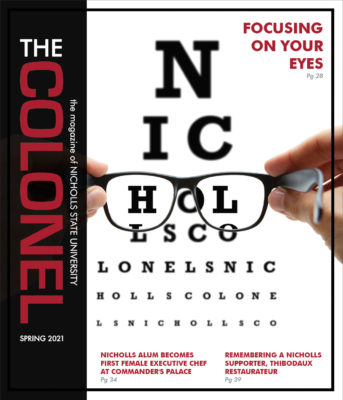 Dr. Ryan Matherne (BS ’02)
Dr. Ryan Matherne (BS ’02)
3 years in practice | Dermatology, Dermatopathology | Matherne Dermatology, Lutcher, Cut Off and Metairie
“From day one, I thought Nicholls prepared me very well for medical school. In fact, my first semester of med school was an easier transition than most students experience thanks to Nicholls.”
When people think of Hansen’s disease, also known as leprosy, they usually think of the Bible story of Jesus healing the lepers. It still has a pretty significant stigma attached to it. Many
people don’t realize that the ninebanded armadillo — common in the south-central United States — carries the bacteria that causes leprosy.
During my first year of residency at the University of Texas at Galveston, I had a patient who had recently noticed red bumps all over his body. The gentleman, who had just retired from a career in the petrochemical industry, had never seen a dermatologist before, but the suddenly appearing lesions caused him great distress. I performed a skin biopsy and was able to determine that he had leprosy.
The patient remembers going fishing back in the ’60s with a friend who cooked some meat and asked him to try it. The patient ate the meat, only later learning that it was armadillo. One theory is that he may have contracted leprosy through consuming that meat. It’s caused by a slow-growing bacteria, so it’s very common for Hansen’s disease to stay dormant in the body for a long time — even four decades.
Due to the chronic nature of the disease, I was able to follow the patient for close to a year, and with antibiotics, he was completely cured. As a dermatologist-in-training, it was amazing for me to have the ability to see this uncommon disease clinically, monitor the patient’s treatment and learn about the many aspects of Hansen’s.
Generally, though, what I see the most of in clinic is premature skin aging and the development of precancerous and cancerous skin conditions. Since the early days of my training, I’ve seen a dramatic number of skin cancers — it’s become an epidemic in the South. The importance of sunscreen and sun avoidance can’t be overstressed, especially to young people. Most of our sun exposure occurs before we’re 18 years old, and once the skin has sustained damage from UV rays, the damage stays with us.
— Written by Stephanie Verdin, publications coordinator
This article originally appeared in the fall 2013 issue of Voila! magazine. Click here to read the entire issue.



